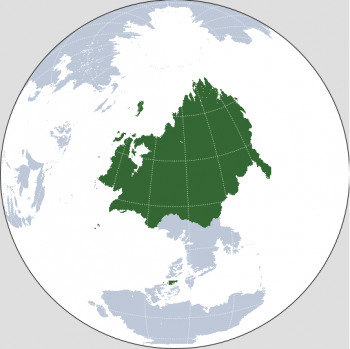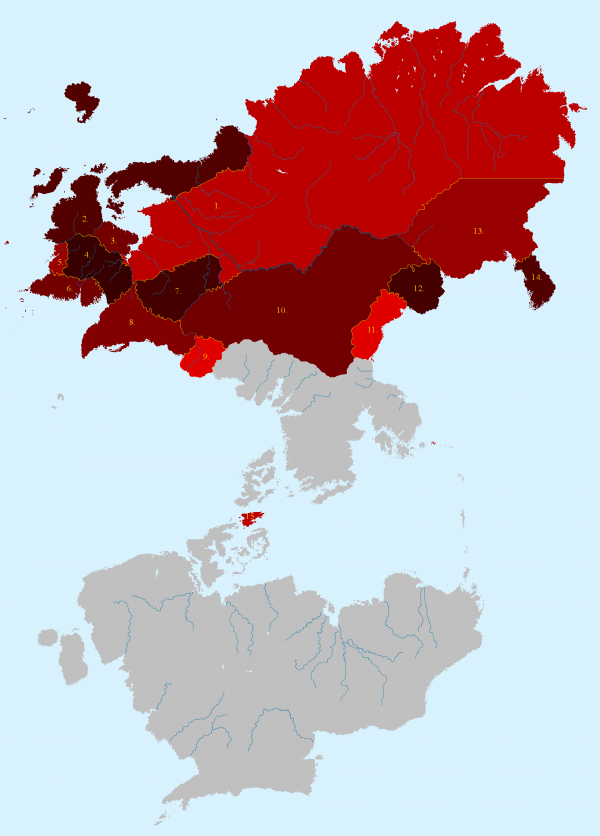Difference between revisions of "Neuvosto Union"
| Line 69: | Line 69: | ||
}} | }} | ||
| − | The Neuvosto Union, officially Union of Sosialistic Neuvosto Republics (USNR) is a socialistic state spanned almost all of Uusimaa continent. Its nominally a federal union of which the Vanaja Federative Socialistic Neuvosto Republic (VFSNR) is the largest and most dominant with Mustova acting as capital of both VFSNR and the whole USNR. Other major urban centers are Leininkaupunki (Kajastus SNR), Uusilinna (Rannikko FSNR), Kieviö (Uhtamus SNR), Kaukaa ( | + | The Neuvosto Union, officially Union of Sosialistic Neuvosto Republics (USNR) is a socialistic state spanned almost all of Uusimaa continent. Its nominally a federal union of which the Vanaja Federative Socialistic Neuvosto Republic (VFSNR) is the largest and most dominant with Mustova acting as capital of both VFSNR and the whole USNR. Other major urban centers are Leininkaupunki (Kajastus SNR), Uusilinna (Rannikko FSNR), Kieviö (Uhtamus SNR), Kaukaa (Kaukava SNR) and Vallinosto (Vanaja FSNR). Neuvosto Union is the worlds largest country by land area and third largest by population. |
| − | The Neuvosto Union was born after the [[October Revolution]] in | + | The Neuvosto Union was born after the [[October Revolution]] in 1871 when the communist [[Enemmistöläiset]], headed by [[Viljo Leini]] overthrew the provisional government of Vanaja. Revolution sparked a civil war between the Enemmistöläiset Red Army and various anti-communist factions and their foreign supporters. Eventually the Enemmistöläiset emerged victorious and Neuvosto Union was formed in 1877 becoming the first socialistic country in the world. Under the leadership of Leini, the Enemmistöläiset started to shape up the new type of nation and actively exporting socialism around the world. This put Neuvosto Union into collision course with the bourgeois countries. The tension between Neuvosto Union and the dominant Ellardae nations sparked into full scale war in 1914 when the Neuvosto Union joined to back up communists in the Nomidaë revolution during the Great War. |
The Great War ended for Neuvosto Union's and the communist Nomidaë's defeat in 1918. This made the Neuvosto Union to give up its aggressive policy of advocating World Revolution and instead it focused on building Socialism in one country. After Leini's death in 1911 Neuvosto Union was ruled by collective leadership of the Politburo but in the after war years [[Seppo Kironen]] became the prominent member of the Politburo and by 1922 had consolidated power to himself. Under the leadership of Kironen, Neuvosto Union saw rapid growth in heavy industry and infrastructure development. Not all were happy of Neuvosto Unions isolationist stand and under the pretext of the assassination of prominent Neuvosto politician and revolutionary [[Touko Peltoinen]] in the Middle Archipelago, a Coup d'état removed Kironen from leadership in 1937. Power was assumed by [[Juuso Talinen]], a hardliner who had worked already under Leini's close adjutant and was prominent world-revolutionist. | The Great War ended for Neuvosto Union's and the communist Nomidaë's defeat in 1918. This made the Neuvosto Union to give up its aggressive policy of advocating World Revolution and instead it focused on building Socialism in one country. After Leini's death in 1911 Neuvosto Union was ruled by collective leadership of the Politburo but in the after war years [[Seppo Kironen]] became the prominent member of the Politburo and by 1922 had consolidated power to himself. Under the leadership of Kironen, Neuvosto Union saw rapid growth in heavy industry and infrastructure development. Not all were happy of Neuvosto Unions isolationist stand and under the pretext of the assassination of prominent Neuvosto politician and revolutionary [[Touko Peltoinen]] in the Middle Archipelago, a Coup d'état removed Kironen from leadership in 1937. Power was assumed by [[Juuso Talinen]], a hardliner who had worked already under Leini's close adjutant and was prominent world-revolutionist. | ||
Revision as of 14:08, 26 December 2021
| Union of Sosialistic Neuvosto Republics Sosialististen neuvostotasavaltojen liitto | |
|---|---|
|
Anthem: Neuvostoliiton hymmi | |
 Location of the Neuvosto Union (green) | |
| Capital and largest city | Mustova |
| Recognised national languages | Evoan, Uusmaa, Ellardaean |
| Ethnic groups (2019) | Rannikkan,Vanajian,Uusmaaian |
| Demonym |
Neuvostan |
| Government | Federal Sajanian-Leininist one-party socialistic republic |
• General Secretary of the Central Committee of the Communist Party of the Neuvosto Union | Valo Puutinen |
• Chairman of the Council of People's Commissars | Timo Karhu |
| Establishment | |
• October revolution | 25 October 1871 |
• Establishment of Neuvosto Union | 30 December 1877 |
| Area | |
• Total | 12,059,908 km2 (4,656,357 sq mi) (1st) |
| Population | |
• 2019 estimate |
|
| GDP (PPP) | 2019 estimate |
• Total |
|
| GDP (nominal) | 2019 estimate |
• Total |
|
| Currency | Neuvosto Union Rouble (NER) |
| Time zone | UTC +2 to +12 |
• Summer (DST) | (UTC+9) |
| Date format | dd-mm-yyyy |
| Drives on the | right |
| Calling code | 00987 |
| ISO 3166 code | NU |
| Internet TLD | .Neu / .co.neu |
The Neuvosto Union, officially Union of Sosialistic Neuvosto Republics (USNR) is a socialistic state spanned almost all of Uusimaa continent. Its nominally a federal union of which the Vanaja Federative Socialistic Neuvosto Republic (VFSNR) is the largest and most dominant with Mustova acting as capital of both VFSNR and the whole USNR. Other major urban centers are Leininkaupunki (Kajastus SNR), Uusilinna (Rannikko FSNR), Kieviö (Uhtamus SNR), Kaukaa (Kaukava SNR) and Vallinosto (Vanaja FSNR). Neuvosto Union is the worlds largest country by land area and third largest by population.
The Neuvosto Union was born after the October Revolution in 1871 when the communist Enemmistöläiset, headed by Viljo Leini overthrew the provisional government of Vanaja. Revolution sparked a civil war between the Enemmistöläiset Red Army and various anti-communist factions and their foreign supporters. Eventually the Enemmistöläiset emerged victorious and Neuvosto Union was formed in 1877 becoming the first socialistic country in the world. Under the leadership of Leini, the Enemmistöläiset started to shape up the new type of nation and actively exporting socialism around the world. This put Neuvosto Union into collision course with the bourgeois countries. The tension between Neuvosto Union and the dominant Ellardae nations sparked into full scale war in 1914 when the Neuvosto Union joined to back up communists in the Nomidaë revolution during the Great War.
The Great War ended for Neuvosto Union's and the communist Nomidaë's defeat in 1918. This made the Neuvosto Union to give up its aggressive policy of advocating World Revolution and instead it focused on building Socialism in one country. After Leini's death in 1911 Neuvosto Union was ruled by collective leadership of the Politburo but in the after war years Seppo Kironen became the prominent member of the Politburo and by 1922 had consolidated power to himself. Under the leadership of Kironen, Neuvosto Union saw rapid growth in heavy industry and infrastructure development. Not all were happy of Neuvosto Unions isolationist stand and under the pretext of the assassination of prominent Neuvosto politician and revolutionary Touko Peltoinen in the Middle Archipelago, a Coup d'état removed Kironen from leadership in 1937. Power was assumed by Juuso Talinen, a hardliner who had worked already under Leini's close adjutant and was prominent world-revolutionist.
Initially the Neuvosto Union remained neutral when the Second Great War started but in order to prevent the Middle archipelago to fall completely under the control of Saaristo, The Neuvosto Union invaded the island of Tesupar in late 1939. This infuriated Saaristo who saw it as a breach of the temrs of the Treaty of Maskar. Saaristo begun to prepare for war against the Neuvosto Union as it felt that no diplomatic solution would be possible. In July 1941 Saaristo attacked to Tesupar against the Neuvosto troops and in the subsequent naval battles of Kalama Islands and North East Sea delivered devastating blown to the Red Fleet. The Neuvosto Union was unable to prevent Saaristo to take over most of the Middle Archipelago and islands in the Silver Ocean. However the huge industrial potential of the Neuvosto Union was put to serve the war effort and by summer of 1944 Saaristo's fleet had been defeated and most of the Middle Archipelago captured by the Neuvosto troops. However, instead of seeking invasion to the main islands of Saaristo, The Neuvosto Union decided to focus its efforts to defeat the now Facist Nomidaë in the old continent. Throughout 1944 The Neuvosto Union had stacked and munstered large land army into Ewo from where it conducted the Irkull Datche landings July 1944, the largest amphibious operation in the world to open up a new front in Ellardae. The Red Army troops alongside with Ewoan allies quickly overran the Nomidaën troops and advanced deep into Ellardae. By the end of 1945 most of Nomidaë fighting capability was destroyed, Red Army already entering the Nomidaë core lands and Rimshack troops closing in from the west. In order to bring the war to its end, force Nomidaë to accept surrender and warn the Communist block to enter into Nomidae, Rimshack dropped nuclear bombs to Ichall and Namor. The Second Great War ended in January 1946.
Contents
Etymology
The word Neuvosto comes from Evoan language and means council or assembly. Alongside with the official name and its acronym, the word Neuvostoliitto is commonly used and the Neuvosto Union is direct translation from it. The neuvosto refers to the workers councils which were organized and formed after the great stock market crash and the subsequent chaos in 1891 which eventually formed the administrative core of the new socialistic state.
History
Main article: History of Neuvosto Union
Government
Main articles: Government of Neuvosto Union and Politics of Neuvosto Union
Pending
Administrative division
Main article: Administrative division of Neuvosto Union
Foreign relations and military
Main articles: Foreign relations of Neuvosto Union and Neuvosto Armed Forces
Pending
Geography
Main articles: Geography of Neuvosto Union and Climate of Neuvosto Union
The Neuvosto Union covers most part of the New Continent and is the largest country in the world by area. Its main cultural and economical center is in the western part of the country, but considerable population concentration lies in the South East parts as well. The North eastern parts, known as Pohja are mostly sparsely populated as is the large southern desert region Aavanne. It had five climate zones: tundra, taiga, steppes, desert and mountains. Highest mountain is the Vallihuippu, at 7,901 meters located in Kajastus SNR.
The Neuvosto Union borders south with Anagrillaë, Anacarchall and Noreem. The Neuvosto Union controls the Sajan islands under the Oversea SNR in the archipelago between the New Continent and Anadak.
Economy
Main article: Economy of Neuvosto Union
See also: Transport in Neuvosto Union and Tourism in Neuvosto Union
Pending
Infastructure and transport
Pending
Demographics
Main articles: Demographics of Neuvosto Union, Immigration to Neuvosto Union and List of cities in Neuvosto Union by population
| Largest cities in Neuvosto Union | ||||
|---|---|---|---|---|
| Rank | Name | State | Population | |
| 1 | Mustova | Vanaja FSNR | 20,213,255 | |
| 2 | Leininkaupunki | Kajastus SNR | 15,174,632 | |
| 3 | Uusilinna | Saaristo FSNR | 9,690,432 | |
| 4 | Vallinosto | Vallintaka SNR | 7,637,387 | |
| 5 | Uljava | Vanaja FSNR | 7,122,240 | |
| 6 | Kaukaa | Far Eastern SNR | 6,385,162 | |
| 7 | Kieviö | Uhtamus SNR | 6,245,051 | |
| 8 | Minskiö | Valko-Vanaa SNR | 6,138,333 | |
| 9 | Virtakoski | Vanaja FSNR | 5,390,000 | |
| 10 | Sajanne | Saaristo FSNR | 4,749,008 | |
Language
Religion
Education
Health
Culture
Main article: Culture of Neuvosto Union
Sport
Main article: Sport in Neuvosto Union


